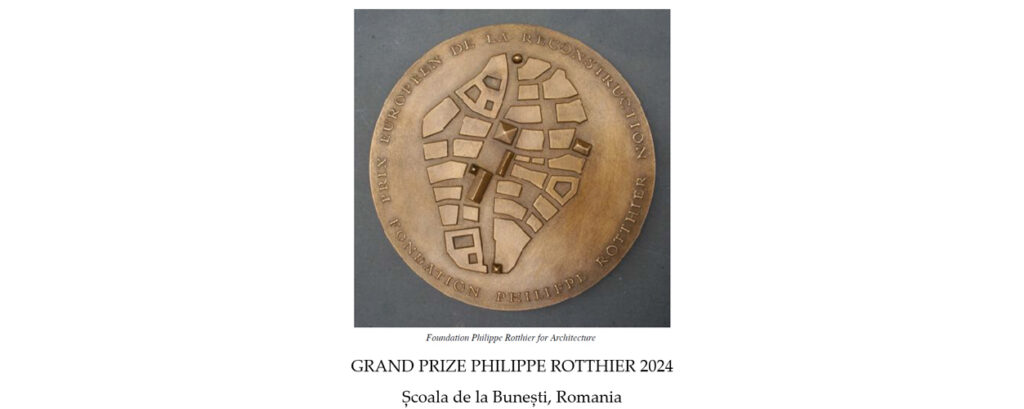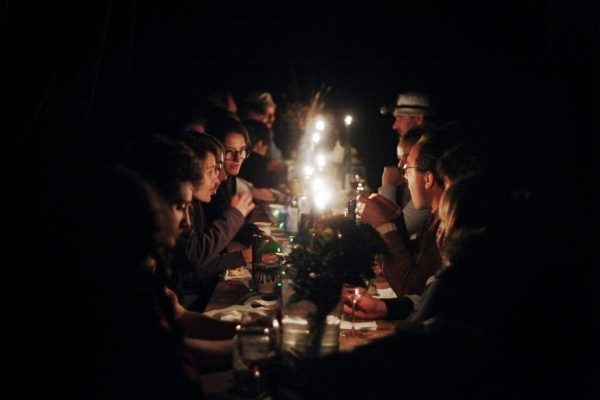
“The Școala de la Bunești project is a remarkable example of the renewal of architecture and culture. Located in the heart of a Wallachian forest, it involves the construction in stages of several pavilions – refectory, arbour, kitchen etc– for and by young people from all over the world with the aim of learning traditional building techniques. Each pavilion is dedicated to a natural material and a specific technique –the Școala de la Bunești thus offers a world tour of vernacular architecture, from Mesopotamian catenary vaults to Caucasian and Egyptian stereotomous prototypes, Vitruvian foundations in burnt oak, Byzantine ductile masonry, Greco-Roman floors in opus lapilli, Oriental tectonic carpentry, Renaissance proportions and classical spatiality. In this veritable laboratory of vernacular architecture, teachers and students work together to build their campus in the form of a training site.
As well as teaching construction methods, the Școala de la Bunești makes a point of restoring the meaning of architecture through the use of ornamental symbolism and by awakening the students’ philosophical sensibilities. The Școala de la Bunești’s concern to save nature from the consumerist rage of post-modern man and the need to save it from its own hedonistic and technological blindness is expressed in the concept of self-limitation. This is nothing more and nothing less than laying the foundations for a new way of living in society that respects our environment.
Launched in 2008 by Ana-Maria Goilav, Doctor in architecture and lecturer at the Ion Mincu University of Architecture and Urban Planning in Bucharest, and Petre Guran, a researcher at the Romanian Academy’s Institute of South-East European Studies, Doctor in the history of civilisations at EHESS Paris, the Școala de la Bunești now has nine pavilions and has seen 1,230 students, 50 professors and 30 craftsmen pass through its doors, making it one of the main places of hope for the revival of vernacular architecture in Europe.”
https://www.rotthierprize.com/_files/ugd/6aa91b_26ee8ad3d06e4a5ab7f183f6eccccb87.pdf

“Weary of the present-day inflation of possibilities for planning, building, learning, and living, and with an increasingly acute sense of the artificiality of our professional training, we—a historian, an architect, and a small group of students—chose to get away from urban scenery and to put ourselves to the test through a summer. We settled in the middle of a forest, giving ourselves time for reflection and action from a radically different perspective. Inspired by classic authors and classical culture, since 2008 we have been taking the local natural building techniques of a Wallachian valley as a guide to the timeless topography of the ancient world.”
The School of Bunesti, Arges, Romania: Hand-made Architecture, A Craft of Self-limitation. Journal of Traditional Building, Architecture and Urbanism.
https://www.traditionalarchitecturejournal.com/index.php/home/issue/view/6/10
„Cunoscutul proiect inițiat de Ana-Maria Goilav și Petre Guran, a primit, la Bruxelles, Marele Premiu Philippe ROTTHIER pentru arhitectură vernaculară. Proiectul a fost în competiție cu alte 189 de proiecte internaționale relevante pentru arhitectura vernaculară.”

„La Bunești, drumul e șerpuit prin pădure, punând la încercare determinarea celor care își doresc să ajungă acolo, în poieniță, unde copiii aleargă după ghebe și mânătărci și unde un arhitect și un istoric experimentează de ani buni arhitectura vernaculară împreună cu studenții.”

„Necesitatea Şcolii de la Buneşti decurge din deriva culturii valorilor locale: ştergerea identităţii rurale, arhitectura împotriva naturii, alienarea creaţiei contemporane de logica structurală a limbajului premodern. Proiectul valorifică resurse locale pentru a inventa arhitectură contemporană, dar în acelaşi timp cercetează şi promovează calităţile arhetipale ale arhitecturii. Astfel, Şcoala de la Buneşti implică forţă de muncă locală şi încearcă revitalizarea meșteșugurilor tradiţionale de pe Valea Vâlsanului.”

„Petre Guran și Ana Ana-Maria Goilav”
Citește mai mult:
https://atelier.liternet.ro/articol/34902/Augustin-Ioan/Scoli-de-vara-III.html

„Cum este să locuiești într-o școală?
Mai ales când școala este în pădure, pădurea e în loc de metodologie și fiecare construcție a școlii este o lecție de arhitectură?”
Urmărește:
https://www.youtube.com/watch?v=lNTb5UHzMTc&ab_channel=UniuneaArhitectilordinRomania

”Meseria mea? Cercetător de locuri.
Când eram copil, credeam că mă interesează să studiez protozoare, și plante, și zburătoare, și cam tot ce crește viu din pământ. Cu timpul, mi-am dat seama că mai tare decât toate mă interesa locul, deci eram un fel de cercetător de locuri, dacă se poate spune așa.”
Urmărește:

În general, sistemul educațional european contemporan are nevoie de o schimbare. Principalul scop al proiectului „Școala de la Bunești” este de a aduce crizei sistemului educațional european o soluție românească prin crearea unei școli alternative destinată tinerilor absolvenți de liceu.
Citește mai mult:

„Școala [de la Bunești] o practicăm ca pe o ocazie de reflecție în primul rând. E și un loc și un timp pe care ni-l dedicăm nouă, nu constrcției. Construcția nu este decât prilejul de a găsi timp să reflectăm asupra lucrurilor pe care le facem și pentru a reflecta asupra a ceea ce suntem sau vrem să fim.”
Urmărește:
https://cinepub.ro/movie/traditii-creative-scoala-de-la-bunesti-film-documentar/

